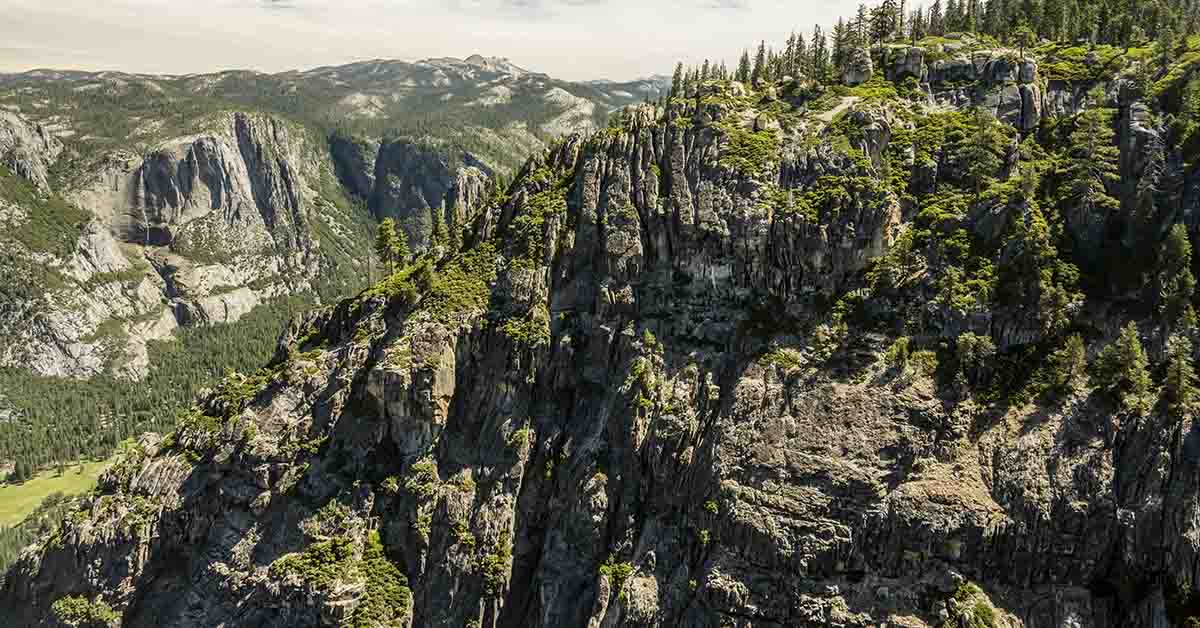Yosemite National Park has always been a magnet for outdoor enthusiasts and adventurers with its majestic landscapes and world-renowned climbing areas. Among its most celebrated climbing destinations, Royal Arches is a testament to nature’s grandeur and human perseverance. However, a recent discovery has sent shockwaves through the climbing community and the park itself. A colossal crack has emerged on the face of Royal Arches, presenting a unique challenge for climbers and raising concerns about safety and preservation.1
The Legacy of Royal Arches
Royal Arches is more than just a rock formation; it’s a living testament to the enduring spirit of climbing in Yosemite. Its history dates back to 1936, when the first ascent was achieved. Climbing Royal Arches is not for the faint of heart; it demands a series of skillful maneuvers and a dash of courage. Starting from a chimney, climbers navigate chockstones, traverse ledges, and face steep, smooth rock faces. The journey culminates in a series of cracks and ledges, leading to a massive hollow flake. After this demanding ascent, climbers merge seamlessly onto a woodland trail, celebrating their victory and connection with nature. However, Royal Arches’s allure extends beyond the climb’s thrill; it serves as a gateway to the renowned North Dome.
The Startling Emergence of the Yosemite Crack
In a place known for its timeless beauty and stability, the sudden appearance of a massive crack has left many in disbelief. Yosemite Park officials first learned about the crack in August. As of the latest reports, this formidable crevice spans approximately 200 feet in length. Yet, its dynamic nature truly sets it apart—this crack is still actively cracking, with the eerie sounds resembling a frozen lake thawing. This phenomenon prompted swift action from park authorities, resulting in the closure of sections of the park. These closures, implemented on August 30, are expected to remain in place until experts can fully comprehend the causes and decide on the appropriate course of action.
Jesse McGahey, a Supervisory Park Ranger at Yosemite National Park, recounted the discovery of the crack. It was initially detected by a Yosemite Mountain School guide who had climbed the area on August 6 and saw no sign of the crack. However, when he returned on August 20, the crack was there, stretching around 200 feet with widths ranging from fingertip-sized to one inch. This rapid development was accompanied by unsettling sounds, akin to the cracking of ice on a lake yet to freeze entirely.
Read: Push these over, say rangers at Yosemite National Park
Understanding the Forces Behind Rock Cracks
While the emergence of a rock crack is not uncommon in geological terms, understanding its causes can be complex. Several factors, including water, ice, earthquakes, and even vegetation growth, can contribute to forming cracks in rock faces. Water, in particular, can exert pressure on unstable rocks, potentially causing them to detach. Additionally, when water infiltrates cracks in the rock and subsequently freezes, it can expand these cracks. This process, known as ‘frost wedging’ or ‘freeze-thaw,’ incrementally dislodges rocks from cliff faces. While these mechanisms offer insights into why cracks form, predicting their future behavior remains challenging.
The crack in Royal Arches is currently expanding at an astonishing rate, approximately an inch per week. However, as is often the case with such geological phenomena, predicting when—or if—the massive rock pillar adjacent to the crack will fall remains uncertain. It could happen imminently or over years. Until experts gain a clearer understanding of the potential threat, parts of Yosemite will remain off-limits.
In response to the crack’s discovery and its potential risks, Yosemite National Park has taken immediate precautions to ensure visitor safety. A temporary area and trail closure have been put in place, encompassing significant portions of the park. This proactive measure aims to mitigate the risk of rockfall-related incidents while geological surveys and assessments are conducted. Areas affected by the closure include the eastern part of the Ahwahnee Hotel Parking area, the Serenity Crack and Super Slide areas, Peruvian Flake to the Rhombus Wall, and the Ahwahnee Boulders.2
The Broader Context of Rockfalls in Yosemite
Rockfalls are not uncommon in Yosemite Valley, and the park has documented over 1,000 significant rockfall incidents over the past 150 years. These natural processes are essential contributors to the park’s unique geological features. Factors such as temperature fluctuations, moisture levels, and shifts in vegetation can all influence the occurrence of rockfalls. While rockfall injuries and fatalities are relatively rare, they are not impossible.
Yosemite’s scientists diligently study and assess the threat of rockfalls within the park’s boundaries. They employ advanced tools, including high-resolution photography and laser mapping, to evaluate the risks associated with various geological formations. Yosemite’s dynamic environment ensures that rockfall hazards can potentially exist on any climbing route and in any area of the park, reinforcing the importance of ongoing monitoring and safety measures.
Yosemite: Where Beauty and Uncertainty Converge
As climbers and park officials closely monitor the evolving situation at Royal Arches, Yosemite remains a place of breathtaking beauty and uncharted challenges. It is a stark reminder that in this wilderness, nature’s allure and its forces’ unpredictability are woven into the fabric of the experience. Yosemite’s visitors and adventurers are invited to explore its wonders while embracing the awareness that the wilderness is ever-changing, presenting new mysteries and challenges to those who dare to venture into its embrace.
Keep Reading: 93-year-old Climbs Yosemite’s Half Dome: ‘It felt pretty good’
Sources
- “An Enormous Crack Has Appeared on Royal Arches, One of Yosemite’s Most Iconic Routes.” The Inertia. Alexander Haro. September 8, 2023.
- “A New 5.10 Crack Appeared Overnight in Yosemite.” Climbing. Mary Beth Skylis. September 7, 2023.

